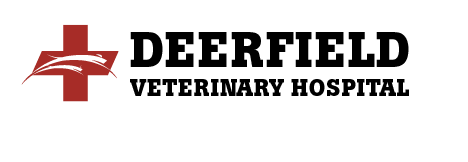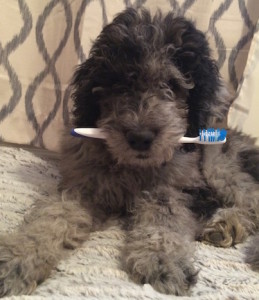Healthy Pets & Healthy Teeth Go Paw in Paw
February was National Pet Dental Health Month, but your furry friend’s oral health should be a priority all year long! According to the American Veterinary Dental Society, more than 70% of cats and 80% of dogs have oral disease by 3 years of age.
Dr. Denise Roche, a Springfield, Mo veterinarian, and the Deerfield staff want to remind you good oral hygiene is crucial for the overall health of your lovable four-legged companion. In fact, periodontal infections in dogs or cats cause far worse than bad breath. Such infections can spread harmful bacteria to the heart, liver, and kidneys. To avoid those life-threatening consequences, pet owners can take precautions against two especially common issues that will eventually leave pets at risk for dental disease: gingivitis and periodontitis.
Gingivitis in dogs and cats occurs when plaque along the gum causes inflammation. Without regular cleaning, the teeth and gums develop a thin film of protein—from food, saliva, and dead cells—that leads to bacterial plaque build-up. Left untreated, gingivitis will escalate to periodontitis, an irreversible but controllable infection. Periodontitis develops when deposits of calcium salts react with bacterial plaque, forming a hard brown or yellow tartar, which leads to inflammation, infection of the deeper tissues, bleeding gums, and eventual tooth loss if not treated by your veterinarian.
How Do I Know if My Pet Has Dental Disease?
Let’s hope your pet’s teeth and gums are tip-top. Better yet, let’s help you guard against the dreaded dental disease. This handy checklist should make it nice and easy to knowledgeably check your pet’s teeth at least once a week:
- Bad breath is bad news for more than just your own nose, especially if it returns within one or two months of a professional cleaning.
- Broken or discolored teeth should sound the alarm.
- Red or swollen gums is a sure sign of irritation.
- Keep your eyes peeled for bleeding in your pal’s dishes or on chew toys.
- Lumps or bumps in or around the mouth, especially swelling on one side, are cause for concern.
- Listen for chattering jaws when eating.
Changes in feeding and chewing behavior can also indicate a problem. If your pet turns away from food, paws at the mouth, drools excessively, or resists having its teeth brushed, it’s time to see your Deerfield vet.
How Is Dental Disease Treated?
A professional cleaning can help reverse, or stop the progression of, oral disease. Should your pet require gingival surgery or tooth extractions, we’ll perform the procedure during the dental cleaning to avoid multiple uses of anesthetics. Feline or canine tooth extraction is not fun for you nor your pet, but sometimes it’s the best option for avoiding further damage from periodontal disease.
How Can I Protect My Pet from Dental Disease?
Proactive care, including regular preventive cleanings and good hygiene at home, can help prevent oral disease in your dog or cat.
Pet Dental Care at Deerfield
Your Deerfield vet can remove bacteria that attack your pet’s gum line. General anesthesia is required for both dog and cat dental cleanings, and safety precautions include pre-surgical blood work on older pets as well as monitoring EKGs and oxygen levels. After polishing your friend’s teeth, we’ll walk you through all you need to know for excellent at-home care.
Pet Dental Care at Home
Good oral hygiene at home is as important for your cat or dog as it is for you, and it begins with a consistent brushing routine. You can remove harmful plaque by brushing your pet’s teeth either daily or every other day. Here’s how:
- First of all, be both gentle and persistent. Chances are you know from experience that brushing your pet’s teeth can prove challenging, but your patient determination is an act of love.
- Never use human toothpaste on animals, as it can upset your pet’s stomach. Your Deerfield vet can help you choose a toothpaste your pet will enjoy—yes, actually enjoy. A good pet toothpaste is non-foaming and comes in flavors that are appealing to dogs and cats. Introduce the toothpaste by using it as a treat, placing it on your finger as a reward.
- Ask us about toothbrushes designed especially for dogs and cats. Once your furry friend accepts brushing movements with your finger, switch to a small, soft-bristled toothbrush. Pointing the bristles at about a 45-degree angle to your pet’s teeth, use small circular strokes and focus on the outside of the teeth.
If your pet resists the at-home dental cleaning at any point, never outmuscle it to force the brushing. The animal may not recognize your concern and could instinctively bite due to fear of the toothbrush. You may also use a soft, clean piece of gauze. If your pet is unable to accept toothbrushing, which does happen sometimes, your Deerfield vet can recommend effective toys, treats, chews, and pet foods that aid your dental cleaning efforts at home. Another option is to choose gels, rinses, or sprays that promote oral health in both cats and dogs.
Tartar removers should always bear the Veterinary Oral Health Council (VOHC) seal of approval, so you can be confident they’re safe for your pet. Visit the VOHC website for a list of approved products like the popular Greenie chew. Finally, ask your Deerfield veterinarian about nutritional options we recommend to promote healthy teeth, such as Hills Prescription Diet T/D.
National Pet Dental Health Month makes February a busy time at Deerfield Veterinary Hospital, and it was great to see so many pets for their dental checkups. Now that the month has past, we want to remind pet owners to keep that loving attention to dental care going strong throughout the year. With consistent hygiene at home and regular cleanings, your pet will enjoy clean teeth and better overall health for years to come!



